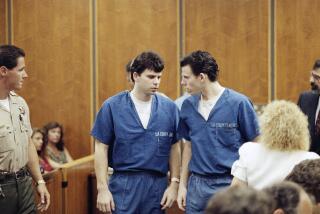Judge Explores Death ‘Machinery’
SAN JOSE — The most detailed hearing ever held on lethal injection in California concluded Friday with a judge exploring a new drug protocol that could prolong condemned individuals’ deaths but also reduce the risk of an inmate experiencing excruciating pain.
The current procedures call for a three-drug cocktail including a barbiturate anesthetic, a muscle-paralyzing drug and a heart-stopping chemical. Critics say the state does not properly administer enough anesthetic to deaden the pain of the final drug, whose effects are masked by the paralytic.
Introducing the possibility of a single-drug protocol, U.S. District Judge Jeremy Fogel asked an expert witness for the state to estimate the length of time it would take to “achieve a flat line” on an electrocardiogram -- meaning someone was dead -- just using “a massive dose of barbiturate.”
“We are looking at 20 minutes at the low end and 40 minutes toward the upper end,” said Dr. Robert Singler, a Napa anesthesiologist.
Fogel is considering a lawsuit brought by death row inmate Michael Morales, who contends that California’s current lethal injection protocol presents an unnecessary risk of subjecting condemned inmates to cruel and unusual punishment in violation of the Constitution.
Morales was originally scheduled for execution Feb. 21 but state corrections officials postponed it after they were unable to meet conditions the judge imposed. Since then, the state has revised the protocol slightly, but has stuck by the three-drug cocktail.
The judge has conducted an extensive review of the issue, going so far as to visit the execution chamber at San Quentin State Prison in Marin County to familiarize himself with the process.
Santa Clara University law professor Ellen Kreitzberg, who attended portions of the four-day hearing, said Fogel was truly delving into “the machinery of death.”
In response to a question from Fogel, Singler said Friday that the paralytic pancuronium bromide could serve a useful purpose by deepening oxygen deprivation to the brain.
Then the judge asked if an inmate were still conscious after the first drug was administered whether the effect of pancuronium bromide “would conceal that fact” from observers outside the sealed execution chamber. “Yes,” Singler said.
Fogel continued to express concern, as he did earlier in the week, that some of the 11 people executed in California by lethal injection were still breathing for several minutes beyond what would be anticipated after the anesthetic was administered.
On Friday, Singler acknowledged that prison logs “raise the question” of whether convicted murderer Robert Lee Massie was awake when the final lethal drugs were injected in 2001. “I don’t dispute that,” Singler said.
The judge also asked Singler about an opinion issued by a federal judge earlier this month upholding Virginia’s lethal injection procedures. In Virginia, according to the decision in Walker vs. Johnson, “the execution takes place in a one-room chamber,” with the inmate strapped to a gurney in the front of the chamber, “and the executioner, IV team and the physician who pronounces death behind a curtain in the rear of the chamber. The curtain has two holes so the executioner and IV team can observe the inmate during the administration of the drugs.”
“The IV team members have backgrounds in relevant medical fields and train on placing IV lines,” the decision stated, and “the executioner has training to determine whether the IV line is flowing properly as he administers the drugs. Also, the executioner can see the inmate and the IV line to determine whether the drugs are entering the inmate’s body properly. If the first IV line is not working properly, the executioner can switch to the second IV line.”
In California, by contrast, the inmate is alone in a sealed chamber and the executioners administer the drugs from a dimly lighted anteroom through IV lines running into the chamber. During the hearing, there was considerable testimony questioning whether the executioners can see what is going on and attacking their capabilities.
Earlier this week Dr. Mark Heath, a Columbia University anesthesiologist who was the primary expert witness for Morales, characterized the team as “dysfunctional,” based on prison records and statements that team members made in depositions.
After reading from the Virginia decision, Fogel asked Singler, “Do you have an opinion on whether what I read to you is of any value in assessing what you saw when you went to San Quentin” to observe the execution chamber and meet with team members a few days before Morales’ execution was to take place?
“There are some improvements in what you read,” Singler said. He also said the lighting in the execution area at San Quentin “is not optimal.”
As he concluded the hearing, Fogel made it clear that the case will not turn solely on courtroom testimony but also on thousands of pages of depositions and 148 exhibits that he will review. He told the lawyers for both sides that he hoped to send them questions by the end of next week on issues that he would like them to focus on in closing briefs, which are due Oct. 27.
Fogel said he hoped to render a decision in early November, although it could take longer. “Let me stress, time is of the essence. I want to get this done so you can move on to the next level of review,” the judge said, acknowledging that the losing side is likely to appeal his decision.
He also emphasized that “it is very important to focus on the issues in this case. There are a lot of issues that swirl around this case -- how people feel about the death penalty, the rights of victims and victims’ families, all of which are very important. But this court has a very specific job to do here and it will do that to the best of its ability.”
Although those comments were similar to remarks the 57-year-old jurist made on the opening day of the hearing, they had added resonance Friday because of the presence of Barbara Christian, the mother of Morales’ victim, Terri Winchell. Christian attended with several friends and her attorney Gloria Allred.
In a hallway after the hearing, Christian told reporters “I am very angry” that so much time is being spent on the issue of whether Morales, who murdered her daughter in 1981, “might be aware” of serious pain for “five to seven minutes.”
Christian reminded reporters that Morales bashed in Winchell’s skull with a claw hammer, stabbed her in the chest with a butcher knife, raped her and finally ran her over with a car. “I want to see him go meet God and let God judge him,” Christian said of Morales.
Now 46, the convicted killer has been on death row for nearly a quarter-century.
henry.weinstein @latimes.com
More to Read
Sign up for Essential California
The most important California stories and recommendations in your inbox every morning.
You may occasionally receive promotional content from the Los Angeles Times.










